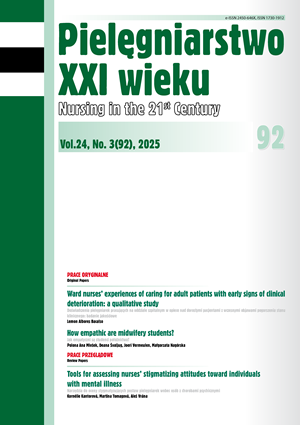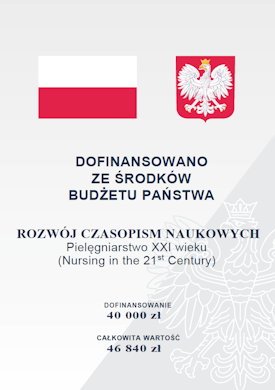Assessment of the functional status of pulmonary patients over 65 years of age
DOI:
https://doi.org/10.12923/pielxxiw-2025-0026Keywords:
functional fitness, elderly, ADL, IADL, NOSGERAbstract
ASSESSMENT OF THE FUNCTIONAL STATUS OF PULMONARY PATIENTS OVER 65 YEARS OF AGE
Introduction. Functional fitness and independence in daily activities are crucial elements that contribute to the quality of life in elderly individuals. The aim of this study was to assess the functional fitness of elderly patients with pulmonary diseases, evaluate their ability to perform activities of daily living (ADL), and examine their cognitive, social, and emotional well-being.
Methods. The study included 80 patients aged 65 and older, recruited from the Kujawsko-Pomorskie Pulmonology Center. Functional fitness was evaluated using the ADL, IADL (Instrumental Activities of Daily Living), and the NOSGER scale.
Results. Over half of participants (57%) were aged between 65 and 74 years, with a balanced gender distribution. Most participants reported having 4 to 5 comorbidities. The mean ADL score was 5.26 ± 1.15. ADL scores were significantly higher in younger participants (p = 0.006) and those who were married (p = 0.015). The mean IADL score was 20.08 ± 4.2, with women scoring higher than men (p = 0.038). IADL scores declined with age (p = 0.042) and increased with the number of comorbidities (p = 0.010). The mean on the NOSGER scale was 65.09 ± 14.10 score, with the greatest impairments noted in social behavior, mood, and instrumental activities of daily living. The highest scores according to the NOSGER scores were associated with more comorbidities and widowhood (p = 0.025).
Conclusions. Functional ability and independence in elderly individuals decline with age and the presence of multiple comorbidities. Gender, marital status, and social support significantly contribute to maintaining independence. The results highlight the need to intensify support efforts for individuals in the oldest age group (85+ years) to help preserve their functionality and independence.
References
1. World Health Organization. Gloon Ageing and Health. WHO, 2015.
2. United Nations. World Population Ageing 2020 Highlights. UN, 2020.
3. Główny Urząd Statystyczny. Prognozy demograficzne na lata 2020-2060. Warszawa: GUS, 2020.
4. Główny Urząd Statystyczny. Roczniki demograficzne 2023. Warszawa: GUS; 2023.
5. Adeloye D, et al. Global burden of COPD and risk factors: a systematic review and meta-analysis. Thorax, 2015.
6. Sharma G, Goodwin J. Effect of Aging on Respiratory System Physiology and Immunology. Clin. Interv. Aging. 2006;1(3):253-260. https://doi.org/10.2147/ciia.2006.1.3.253
7. Gagnon M, Flint AJ. Utility of functional assessment tools in geriatric populations. J. Geriatr. Psychiatry. 2003;17(1):56-64.
8. Spiegel R, Brunner C, Künzli HA. NOSGER: Assessment of functional capacity in elderly patients. Aging. Clin. Exp. Res. 1996; 8(5): 403-411.
9. Fedyk-Łukasik M. Całościowa Ocena Geriatryczna w codziennej praktyce geriatrycznej i opiekuńczej. Geriatria i opieka długoterminowa. 2015; 1: 1-5
10. Krzemienicki K. Całościowa ocena geriatryczna i jej znaczenie kliniczne w onkologii – systematyczny przegląd piśmiennictwa. Gerontol. Pol. 2009; 17(1): 1-6.
11. Wahle M, Haller S, Spiegel R. Validation of the NOSGER (Nurses’ Observation Scale for Geriatric Patients): reliability and validity of a caregiver rating instrument. Int. Psychogeriatr. 1996: 8(4): 525-547.
12. Horgan S, Prorok J, Ellis K, et al. Optimizing older adult mental health in support of healthy ageing: A pluralistic framework to inform transformative change across community and healthcare domains. Int. J. Environ. Res. Public Health. 2024; 21(6):664. https://doi.org/10.3390/ijerph21060664
13. Heide SK. Autonomy, identity and health: defining quality of life in older age. J. Med. Ethics. 2022;48:353-356. https://doi.org/10.1136/medethics-2020-107185
14. Moradoghli F, Darvishpoor Kakhki A, Esmaeili R. The association between frailty and dignity in community-dwelling older people. BMC Geriatr. 2022;22:344. https://doi.org/10.1186/s12877-022-03056-w
15. Fidecki W, Wysokiński M, Wrońska I, et al. Elementy kompleksowej oceny geriatrycznej w praktyce pielęgniarskiej. Prz. Med. Uniw. Rzesz. Inst. Leków. 2011; 2: 205-211.
16. Głowacka M, Brudzińska I, Kornatowski T, et al. Functional ability of elderly people living in their home environment according to the NOSGER. Gerontol. Pol. 2017; 25; 242-247.
17. Nowak J, Kowalski M, Zielińska A. Analiza czynników wpływających na sprawność funkcjonalną seniorów. J. Geriatr. Care Res. 2020; 12(3): 45-56.
18. Smith RJ, Brown K, Taylor L. Functional independence and quality of life in older adults: The impact of chronic diseases. Ageing & Health. 2018; 34(2): 112-121.
19. Brown L, Anderson P, Jones S. Cognitive and functional decline in the elderly: A longitudinal study. Aging Psychology Quarterly. 2019; 29(4): 178-189.
20. Kowalski T, Zieliński P, Adamska M. Wpływ stanu cywilnego na poziom niezależności życiowej wśród seniorów. Polish Journal of Gerontology. 2021; 8(1): 33-42.
21. Jones MA, Taylor K, White R. Gender differences in cognitive aging: A review of the evidence. J. Gend. Stud. 2020; 15(6): 245-260.
22. White T, Green S, Phillips H. Widowhood and its impact on mental and physical health in older adults. Social Science Review. 2019; 27(7): 405-418.
23. Starczewksa M, Prociak L, Markowska A, et al. Ocena sprawności funkcjonalnej osób w podeszłym wieku. Problemy Pielęgniarstwa. 2018; 26(3): 222-227.
Downloads
Published
Issue
Section
License
Copyright (c) 2025 Agnieszka Pluta, Alicja Marzec, Eliza Poturalska, Marzena Humańska (Autor)

This work is licensed under a Creative Commons Attribution 4.0 International License.




